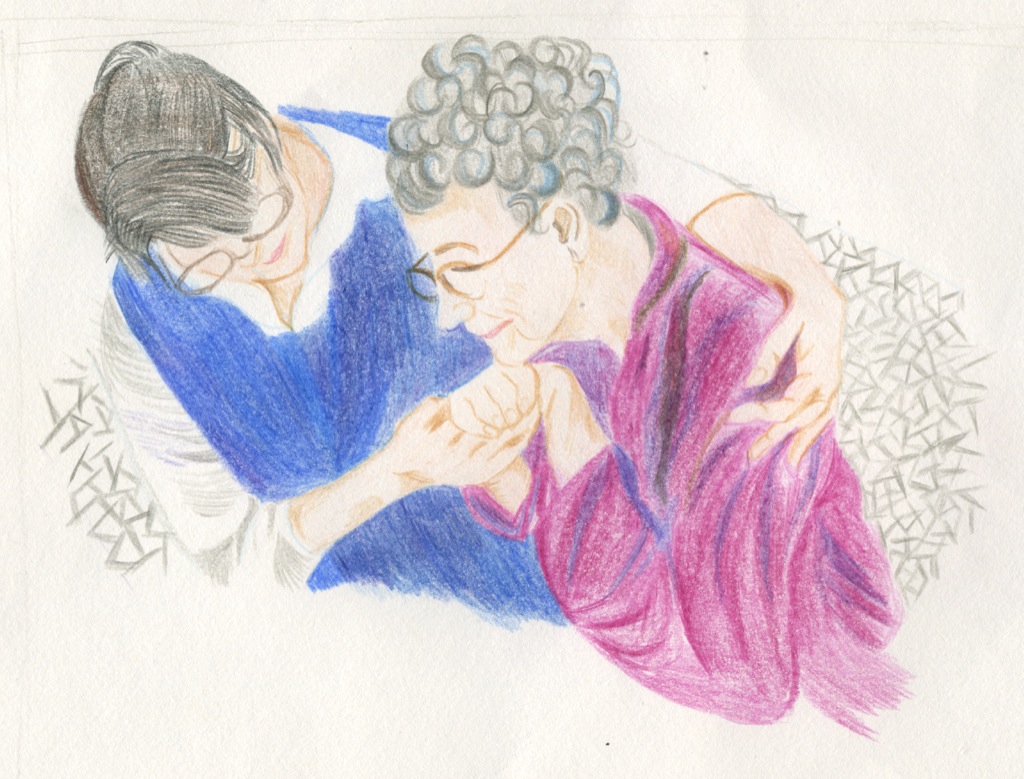BERG Balance
This lady is having a BERG balance test done by a physiotherapist on the ward. The test is designed to see how mobile the patient is and to give an indicator as to the level of care required. The lady was fairly stable when standing but she had difficulty moving and had bradykinesia. What struck me was her determination to try and ‘do well’ with the test and her obvious frustration when unable to perform the actions that she had in her mind. The physiotherapist was very supportive and didn’t try to rush her. This scenario highlights the multidisciplinary approach that older patients can benefit from in hospital.
The drawing was executed with the artist Elizabeth Peyton in mind. Peyton uses colour beautifully – I admire her skill to get colour saturation and hue to balance in her pieces.
Whole Person Care – Year One

You may admire Peyton. I admire Oakes
This drawing appeals to me and I can relate it to my volunteer experience at the Assisi Hospice when I was back in Singapore. It shows the importance of the multidisciplinary approach of medicine. You can see how the frail elderly is holding on tightly to the staff, showing how important the staff is to her and how much she trusts the staff. A patient’s contact time with the doctor is very short but can spend enormous amount of time with the other healthcare professionals. At the hospice I volunteered with, it was the nurses that the patients were most familiar with and close to. The nurses work extremely hard and go out of their ways to meet the patient’s needs. This support was crucial to help the terminally ill patients and their family in through their journey. In conclusion, this drawing captures the essence of the impact of the multidisciplinary approach.
I really value the idea from this drawing that medicine is all centred around the patient. Throughout my first few weeks now at medical school being able to visualise that all you learn and are taught is all to do with caring for and saving the lives of others around you in society. Through this picture I am now able to see that medicine isn’t just about being taught how to save individual lives through knowledge but through the way you provide that knowledge and care to your patients. This drawing shows me how valued all members of the multidisciplinary team are when that extra mile is gone for individual patients.
This image reminds me the work I have done as a health care assistant at a nursing home. When a patients gets to the point where they cannot do something on their own they will entrust in us as a member of the multidisciplinary team to help. The drawing highlight very well the amount of trust the lady has in the physiotherapist. She is holding onto her with both hands, the physiotherapist has one hand over the lady’s back, providing support. This same amount of trust and support is needed between doctors and patients.
I love how this image centres on the holistic aspect of medicine, showing how medicine is not just academic skill based but requires interpersonal skills too. It also highlights how not every problem doctor’s or healthcare professionals face will be one that is immediately curable or treatable or even something that you can have any major influence over how the body heals or time taken rather it is in the patients hands and you can only be supportive and patient.
This picture illustrates the kindness and care of the health care professional, supporting the patient both physically and emotionally. The fact that the older person is so dependent on the assistance shows vulnerability and I really like how the vivid blue contrasts with the pink shade which shows the stark differences between the 2 roles. I also like how the picture just focuses on the 2 people and the background is blurred out, which implies that in that moment, nothing except this interaction matters.